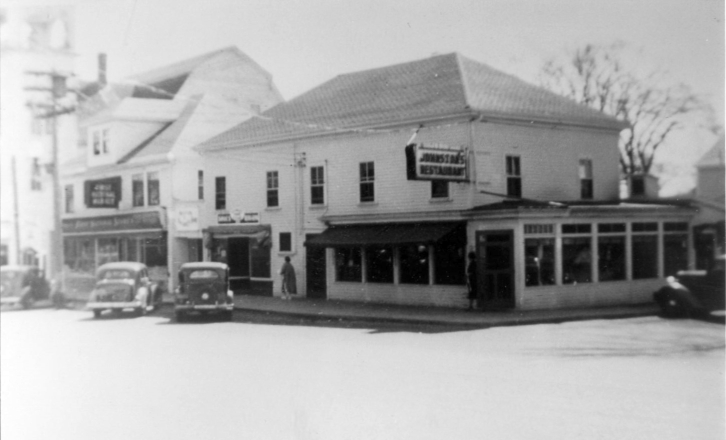By Susan Morse
Hampton Union, Sunday, November 24, 2002
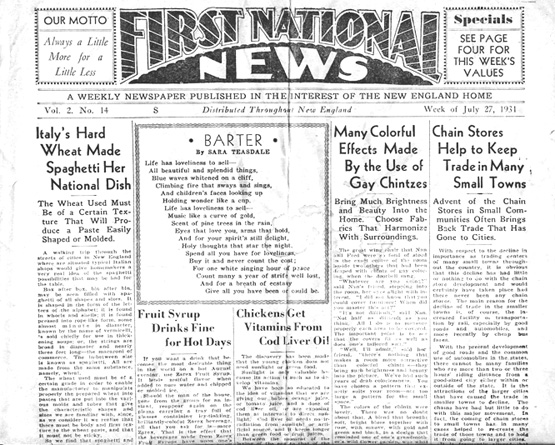
New England home.’ This one is dated July 27, 1931.
{Newspaper courtesy of John M. Holman}
HAMPTON — There are many in town who remember the First National, a grocery store that stood on the spot of what is now the expanded Caffé Fresco.
Like time travelers watching a changing scene in the same space, construction workers stumbled upon a whole new store beneath the former Bib ‘N Crib when they began renovating the space.
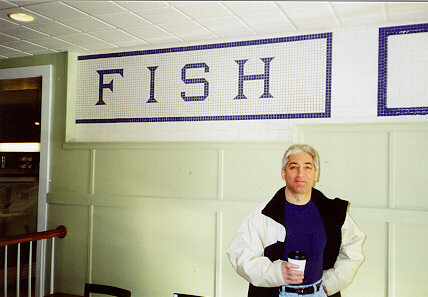
of the mosaic FISH tile in the former Meat department.
[Photo by John M. Holman]
A drop ceiling masked ceilings of tin, a rug hid maple floors; and tiles spelling “Fruit” and “Fish” came to light beneath walls.
Hidden still on another wall farther back in the store was a sign for “Meat,” says John Holman, a former employee of the First National, also called “FINAST”, store.
Holman worked in the produce department of the small store starting in the late 1940s. His father owned Wayside Farm on Mill Road, so he had the expertise in fresh produce.
Holman has followed the renovations and the revelations of the old grocery with interest.
He remembers throwing green sawdust covered with oil down on the wood floors at night. When the floor was swept in the morning, the floor would be freshly cleaned and oiled.
Holman believes the grocery opened in the early ‘30s and remained until a new FINAST opened in the building just north of Lamie’s Tavern in the 1960s.
Three First National stores also existed in Exeter and three in Portsmouth, Holman says. [The chain was only in New England at that time.]
Former employee Richard Chevalier worked in the grocery department.
The store had two big front windows, one displayed groceries, another produce, he says.
Back then, customers brought in lists that they handed to the clerk who rounded up the groceries.
“If you wanted a package of Corn Flakes, I’d have to go get it,” Chevalier says.
There were no long aisles of cereals to select from. The three brands were Corn Flakes, Shredded Wheat and Rice Krispies, he says.
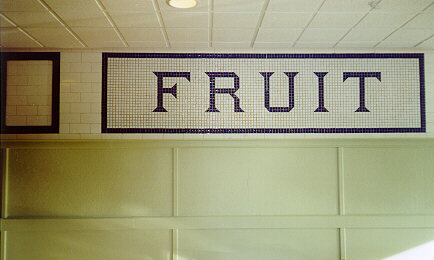
[Photo by John M. Holman]
Meat and fish were cut to order. Holman often filled in at both counters.
“Back then there was an art to filleting haddock,” Holman says.
“Baked, broiled, fried or chowder?,” Holman would recite to customers. For baked, Holman would remove the bone. Holman also remembers the meat slogan: “We got beef, pork, lamb, ram, sheep, liver and tripe.”
Because the shop was small, extra groceries were kept in the cellar. Chevalier remembers often running downstairs for cans of tuna fish and crab meat.
There was a cat who kept the mice out. The manager was allowed a dollar a week for cat food.
“The cat — black and white with a bobbed tail — had a spot near produce,” Holman says, though fortunately, not on the produce. “She raised Cain with the dogs that came in.”
The big night to shop was Friday. All stores in downtown Hampton were open until 9 p.m. and people got paid on Friday.
“The husband and wife would come uptown to shop,” Chevalier says.
Across the street at Marelli’s Market, the afternoon coffee regulars remember well shopping at Finast on Friday nights.
There was also an A&P Supermarket across the street, says John Woodburn, who serves on the Hampton School Board. Marelli’s, which remains a grocery store, had a butcher shop in back.
Mondays at Finast were spent stocking shelves. Deliveries were made during the night. The driver had a key to the front door, but could only access a small area because of a tent that was pulled down around the front entrance at night. Some of the produce in the store came from the Wayside Farm.
Holman remembers the first batch of frozen food that ever came in: Bird’s Eye peas, french fries, strawberries and orange juice.
The store was closed [Armistice Day then], now Veterans Day, Columbus Day, Memorial Day, Christmas, Thanksgiving, Easter and New Year’s Day.
“It was real family oriented,” Holman says.
Hampton Center Through The Years
Hampton, New Hampshire

Left to right: Odd Fellows Building, “Charlie’s Lunch” [Charles Kierstead], First National Stores (FINAST),
a tailor shop, & Fearer’s(?) shoe store.
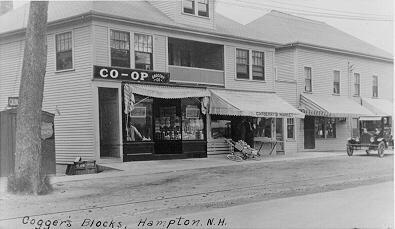
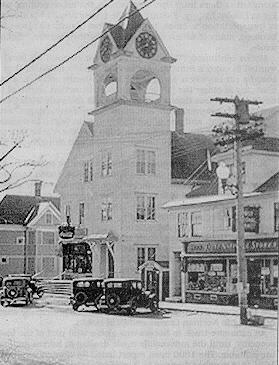
“Charlie’s Lunch”,
First National Stores, Inc., c. 1930s.
